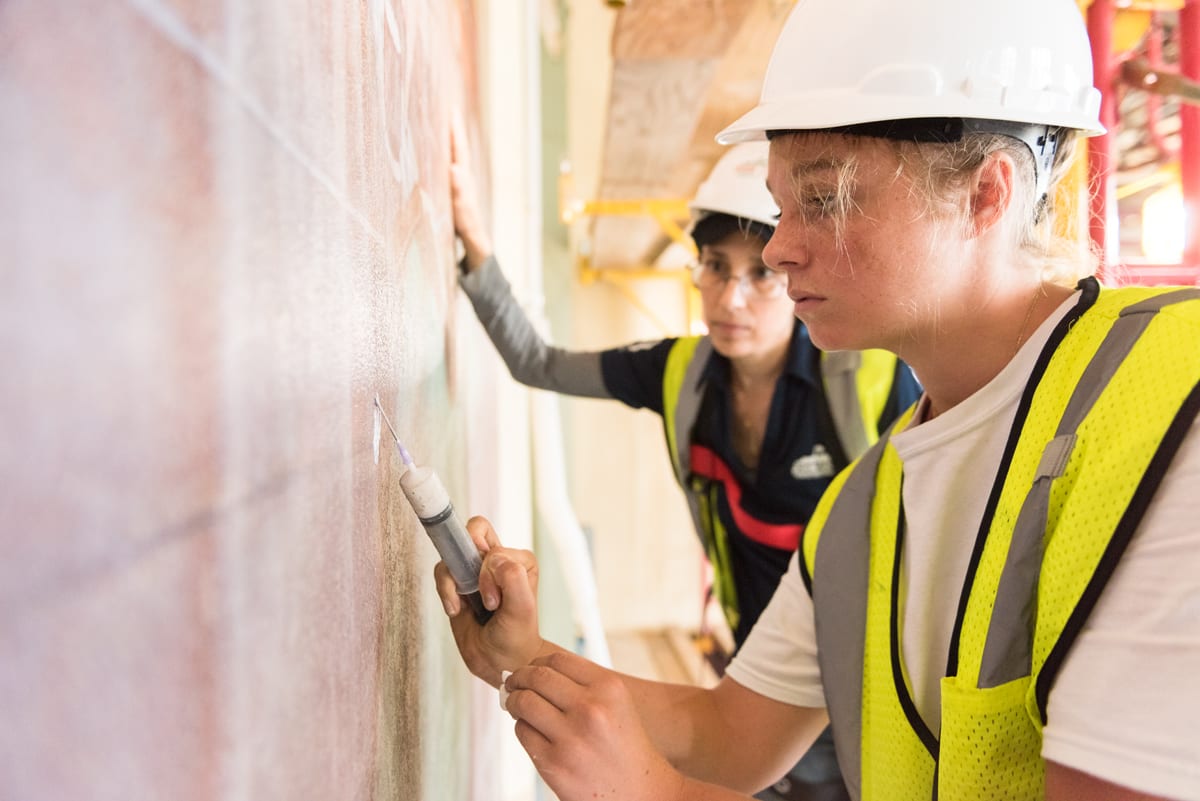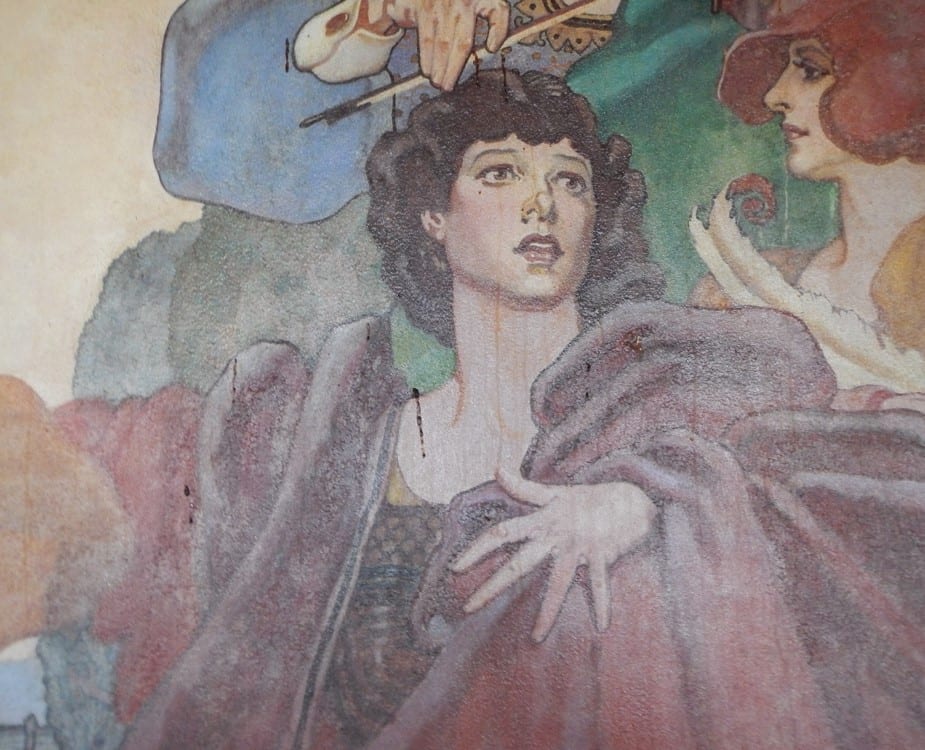The Great Room murals, painted in 1934 by David Hicks Overmyer, are the most iconic works of art on the K-State campus
During the fire, some of the most serious damage occurred in the Great Room ceiling immediately above the murals. Water from both the sprinkler system and from the firefighting efforts on the roof saturated the wall and dripped over the surface of the paintings. Then, in the following days, the plaster and masonry wall behind the mural absorbed a large amount of water that was still flowing through the building.
Hale Library Great Room – 07/20/2018 – Spherical Image – RICOH THETA
Early June
Since early June, the future of the Great Room and its murals have been in the hands of Julia Mathias Manglitz, preservation architect with TreanorHL.
Manglitz examined the murals post-fire. At that time, she worked from a lift to document soiling and streaking on the paintings that resulted from sap running from wood trim directly above. The murals were also stained by dirty water that came from the attic. Additionally, Manglitz discovered areas where paint was cracking and areas that were already exhibiting very small areas of paint loss.

When public information officer Darchelle Martin spoke with Manglitz in late July, Manglitz explained that the murals are painted directly on plaster that is attached directly to the masonry walls. In other words, the paint needs to adhere to the plaster, and the plaster needs to adhere to the walls.
“If we lose the plaster, we’ve lost the paintings as well,” Manglitz said. “So I inspected the murals as closely as I could by doing what’s called ‘sounding.’ When we work with materials like plaster and stone, we tap on them with a rubber mallet, and depending on what sound comes back to us, we can tell if something is well-bonded. Hollow sounding plaster is an indication that layers of plaster are starting to delaminate from each other or from the masonry. On my initial evaluation, even though I wasn’t seeing plaster coming away from the walls except in small areas, what I found were large areas that sounded hollow.”

Late June
Between concerns for paint loss and the potential for plaster loss, Manglitz decided to contact a conservation contractor as quickly as possible. Based on her experience working with John Canning Company on the extensive renovation and restoration of the Kansas Statehouse in Topeka, she recommended they be brought onto the project.
Rachel Gilberti, chief conservator at John Canning, has been working in Hale Library since June 22.
Once Gilberti joined the project, more intensive mapping of the mural damage began. By this time, scaffolding had been erected so they could finally make a thorough, up-close examination. They discovered small areas of plaster deformation where it was starting to delaminate from the wall. Other areas of the paint were marked by a fine pattern of dense cracking called craquelure.

“Water escapes through the cracks, which is a good thing, but sometimes the paint can come off, too,” Manglitz said.
Gilberti also noted that it’s important that the wall needs to dry at a stable rate. “If it starts to dry too quickly, the layers begin to separate from one another,” she said. “It’s also important to have the wall dry from both sides and meet in the middle. If it dries just from the back, all of the salts in the stone get pulled into the front and the material on the surface of the stone will come out.”
It could be a long time before the walls are thoroughly dry.
“The walls are fourteen inches thick, and the general rule of thumb for drying mass masonry is one inch per month,” Manglitz said. “That said, it doesn’t have to be perfectly dry before we start the conservation process to visually restore the appearance, but we needed to get it to the point where we feel like it’s safe.”

Late July
When the wall started to dry, additional small areas of paint began to flake off. Gilberti and her team began a triage campaign to repair small areas of damage and prevent others from worsening.
They used syringes to insert thermoplastic adhesive where they found paint cracking and peeling. Once the adhesive seeped in, they placed a clear piece of mylar over it and heated it with a small iron to get it to set. The process helped them keep the paint layer in place and on the wall.

As they monitored the drying-out process and addressed the paint delamination, they noted that different colors of paint reacted differently.
“Each color, each pigment in itself has unique traits,” Gilberti said. “Some pigments have less binding in them. All the reds in general are more sensitive pigments, so they react differently, especially to water. Greens are also very sensitive. White is a very stable pigment, so paints mixed with white did very well. The ones that don’t have that extra binding power are what we tried to stop from flaking with the thermoplastic adhesive.”
August
Since the beginning of their efforts to preserve the murals, Manglitz and her team have been collecting data regarding how wet the walls are. Initially, they could only take measurements at the surface, but since then, they’ve inserted probes seven inches or eight inches into the masonry to determine the moisture levels inside the walls.

“Once we determined that the easternmost mural, Industry, was dry and stable enough, we were able to do a surface cleaning to remove the drips from the wood trim above without having paint actively flake off,” Gilberti said. “After that we began removing the varnish coating.”
The protective varnish was applied the last time the murals were cleaned and restored in 2011. Stripping that layer will increase the breathability of the wall.
As the process of stabilizing, drying, cleaning and stripping the murals of varnish continues, Manglitz and her team have several important questions to weigh regarding next steps.

“We need to decide when it’s appropriate to do the conservation work on the murals given amount of repair that has to be completed in the rest of the space and above this space,” she said. “Roof repairs come with the risk of water infiltration, so we’ll be asking ourselves, ‘What can we do to protect the murals? When do we think it’s appropriate to move forward with conservation? What should the sequence be?’”
Even though those questions haven’t been fully answered yet, Gilberti is confident that they will find a way forward to ensure the future of the Great Room murals.
“Every piece of art is salvageable,” she said. “Conservators are here for exactly that reason, to salvage the artwork and preserve what the original artist’s intent is. It’s not one of those situations where they’re going to disappear: They will be saved. We’ve just got to assess as we go. The murals will have damage, but we are here to mitigate that.”